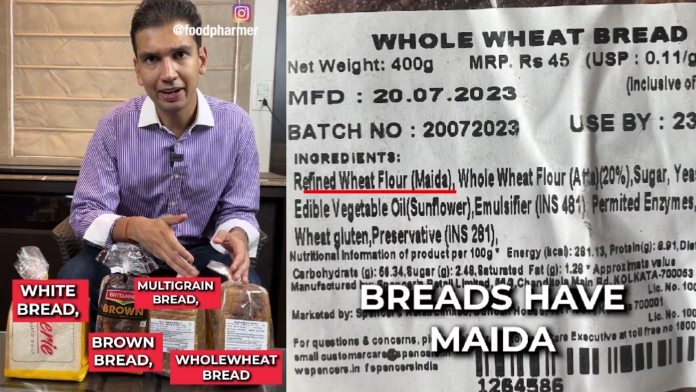Revant Himatsingka, known as Food Pharma in the social media sphere, gained prominence for shedding light on the elevated sugar content in Bournvita, leading to Cadbury serving him with a legal notice. Now, he has redirected his attention towards exploring the veracity of the claim that brown and multigrain bread truly offer a healthier alternative to conventional white bread.
Read More: Bournvita refutes social media influencer’s high sugar content claims, deems video ‘unscientific’
“Bread in India is a big joke!” Himatsingka said. “There are two types of bread in India. One which is openly unhealthy (white bread), and the second type (brown, multigrain, wholewheat) which pretend to be healthy when they are not!”
In a tweet, Himatsingka pointed out that bread consumption has experienced a notable surge in recent decades, exacerbating the issues associated with its consumption.
“Till a few decades ago, bread wasn’t as common in India. But now it is commonly used by Indians for breakfast sandwiches, school tiffins, and snacks!” the Food Pharma tweeted. “If you have 2 slices of bread a day, you have more than 700 slices in a year. Make sure you pick the right one!”
Explaining white bread is made up of maida or refined flour which has very little nutritional value, he said, “The maida is created by polishing the wheat which removes its layers of fiber.”
“Brown bread in India is also not healthy,” Himatsingka said in his video showing how the brown colour of the bread is achieved through colour and not because it is made up of wheat flour. “They are brown because of a caramel colour 150A. This caramel colour is similar to the colour in Coca Cola and Bournvita.”
Referring to the third type, which is multigrain bread, the food influencer remarked that it also didn’t consist solely of wheat flour.
“According to FSSAI, ingredients are listed in order of weight. Most whole-wheat breads have maida as the first ingredient and use very less whole wheat.” He then pointed out that a particular variety of whole-wheat bread had only 20 percent whole wheat.
“They just add a little bit of whole wheat so they can call themselves whole wheat bread,” Revant Himatsingka said. “Multigrain bread also does not mean it’s healthy. It just means that it has more than one grain. Most multigrain breads in India are also mainly made up of maida,” he added pointing to a particular brand of bread that has more maida than wheat flour since the refined flour was mentioned first in its list of ingredients.
Advising people to opt for wheat flour rotis instead of bread, the Food Pharmer added that if people still want to continue eating processed bread, they should check the ingredients listed on the packet and avoid varieties that have maida, palm oil and preservatives such as those available from local bakers.





